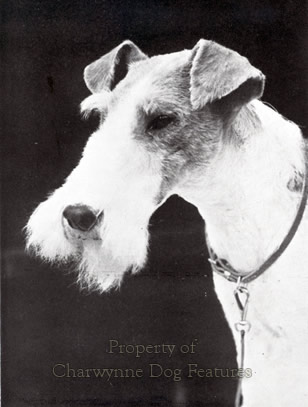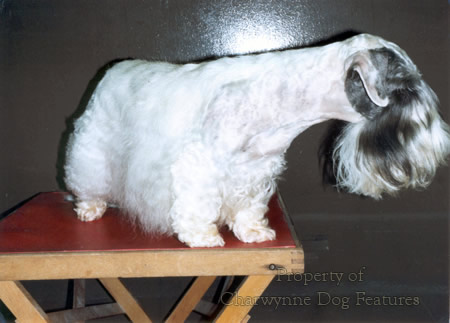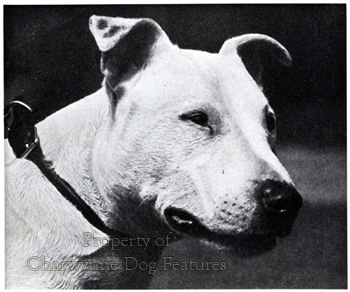880 HEADS YOU LOSE
HEADS YOU LOSE - Reshaping The Terrier's Skull
by David Hancock

 We hear lots of arguments about a terrier's height, weight and coat colour but it's unusual nowadays, away from the show ring that is, to have a discussion about the head of the working terrier, the shape of its skull for example. I hear mentions of the need for a punishing jaw but no words on what such a jaw might look like. I have long favoured what I term the 'rat-trap' jaw for terriers, a balanced symmetrical jaw built round a powerful masseter muscle for gripping. The show breeders have gone for length - in the Fox Terrier jaw, or increased size - as in the jaw of the Sealyham, Scottish and Glen of Imaal breeds. The worst infliction on any terrier breed however is in the Bull Terrier, with the freak uniqueness of its so-called 'downface'.
We hear lots of arguments about a terrier's height, weight and coat colour but it's unusual nowadays, away from the show ring that is, to have a discussion about the head of the working terrier, the shape of its skull for example. I hear mentions of the need for a punishing jaw but no words on what such a jaw might look like. I have long favoured what I term the 'rat-trap' jaw for terriers, a balanced symmetrical jaw built round a powerful masseter muscle for gripping. The show breeders have gone for length - in the Fox Terrier jaw, or increased size - as in the jaw of the Sealyham, Scottish and Glen of Imaal breeds. The worst infliction on any terrier breed however is in the Bull Terrier, with the freak uniqueness of its so-called 'downface'..jpg)
In his book on the Bull Terrier, terrier-expert Tom Horner wrote: "...concentration on downfaces brought the conformation and movement of the breed to an appallingly low level...There were some clever breeders...the majority quite single-minded about breeding bigger and better downfaces." Such comments on the breed and its breeders are not new. In his 'Points of the Dog' of 1927, Hancock-Mountjoy wrote on the Bull Terrier: "The majority of the judges seem to make a fetish of head, and nothing but head. On going round the benches, it breaks one's heart to see the slab-sided, greyhound bodied specimens, placed in the money. Some other faults are snipey faces, small round pig eyes, dudley noses, long backs, no spring of rib, throatiness."
Bigger and better downfaces and pig eyes are with us today and how they spoil the appearance of this splendid breed. The breed standard sets the design of the dog's head with these words: "Viewed from front eggs-shaped and completely filled...Profile curves gently downwards from top of skull to tip of nose..." But in Vero Shaw's 'The Illustrated Book of the Dog' of 1879, the 'points of the variety' demanded a wedge-shaped head, with an oblong eye. Then sixty years ago this standard demanded a head which was "Oval, almost egg shape" with "The more down-faced the better." The significance of Hinks, the father of the breed, never desiring a dog with an egg-shaped head and bigger and better downface is carefully overlooked in the pursuit of modern whim. It is a wholly undesirable feature, never found naturally in dog and one which will go on exaggerating itself until a proud breed looks like a caricature of itself.
The head of dog seems to preoccupy far too many breeders in far too many breeds. And, although I shudder when I hear a breed described as a 'head breed', an unusual fascination with the head of dog need not be damaging -- until it affects the health and well-being of the dog. A preoccupation with the head, leads not only to a neglect of the rest of the body but a harmful imposition of owner or breeder whim on a hapless animal. The heads we have inflicted upon a number of contemporary pedigree breeds demonstrate very aptly man's preference for his fad as opposed to dog's needs. It is simply not honourable to claim lamely that 'their heads have always been like that'. The honest man knows that that is not true, not historically correct. The honourable man knows that to breed subject living creatures to a harmful design is immoral, shameful and inexcusable..jpg)
The Kennel Club, commendably, has in recent years looked at harmful descriptions in a number of breed standards, but in my view failed to act with authority and continued to walk around the breed clubs on this issue. Overseas kennel clubs are just as guilty, but since we created more breeds of terrier (and dog) than any other nation, we surely have a special duty to look after them. Self-regulation that works must always be better than direction from outside, but in these days of militant animal welfare groups, it is surely preferable for the relevant authorities to put their own house in order. The KC-approved breed standard of the Bulldog needs 258 words to describe the head and an additional 200 to describe the ears, eyes, mouth and neck. Only 13 words are apparently required to cover temperament and 33 to describe gait or movement. They need a good editor! A new look at priorities might help too.
A judge at a KC-sanctioned show once gave this report on the terrier entry: "I was disappointed with the quality of my entry, too many had heavy cheeks, absolutely foreign to the Standard." Now there's a valuable yardstick for passing judgement on a breed designed to work! "Tell me, terrierman, what's the problem?" says the MFH. "Sorry, Sir John, but they've all got heavy cheeks - I don't think we'll be going out today." No marks for guessing at the MFH's response!